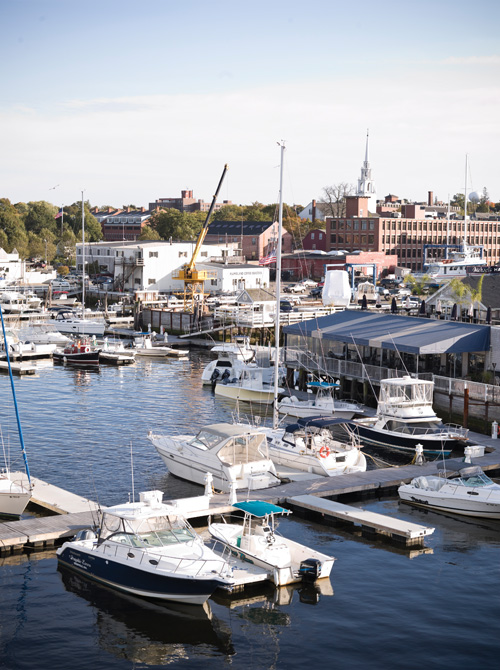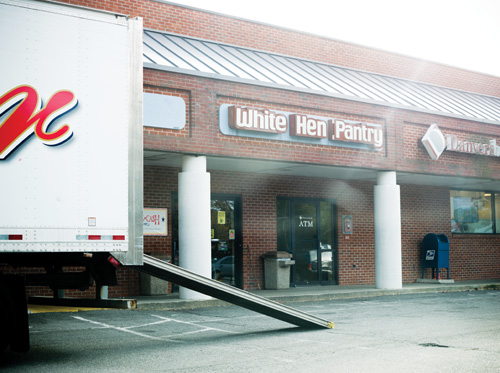Written by Bryan McGonigle
Photographs by Christopher Churchill
As Ann Lagasse walks along Green Street in Newburyport, talking to residents and noting the new businesses she’s helped bring to town in the past decade, she stops here and there to admire the flower beds that New England Development supplies to its tenants. “We’re definitely a downtown, but we’re looking to attract staple stores, too,” she says. “That way, we’re not all coffee shops and banks.”
Yet much of the waterfront remains undeveloped. And across town, a petition at a local market gathered thousands of signatures aimed at saving that market from being replaced by a CVS, the latest phase of frustration for some Newburyport residents.
“The face of Newburyport has changed to an almost faceless town, with a few people in control sporting dollar signs in their eyes,” says local resident Lisa Hayford. “Newburyport’s soul was sold to a commercial devil, and now the residents are paying the price.”
An evolving makeover of the downtown area, combined with a dismal economy that has stalled long-awaited major renovation of the waterfront and a caused a visionary tug-of-war, define the ambitious and often exhausting course of progress in Newburyport.
Newburyport has a long history of financial advantage. Born in 1764 after Newbury’s port community prospered so greatly that it broke away from the rest of the town (and later annexed parts of Newbury to incorporate itself into city status in 1851), Newburyport became an epicenter of shipbuilding and trade during and following the American Revolution. The United States Revenue Cutter service-the predecessor to the US Coast Guard, which was established to fight smuggling-opened its first station in Newburyport in 1791, and lighthouses built by the Coast Guard still stand on Water Street and Plum Island. Newburyport was also a base for the privateer ships that attacked enemy ships that captured hundreds of British ships during the American Revolution and War of 1812.
 Ships from all over the world registered their foreign goods at Newburyport’s Custom House. In turn, those built in Newburyport carried American goods around the world. The Currier yard built 97 vessels totaling more than 80,000 tons. Famous shipbuilder Donald McKay set up his operation in Newburyport and introduced clipper ships-famous for their grandeur, grace, and speed-in the mid-19th century. The shipbuilding district was overlooked by Federal-style mansions of the region’s famous shipbuilding families, including the Greenleaf, Cushing, and Bartlett clans.
Ships from all over the world registered their foreign goods at Newburyport’s Custom House. In turn, those built in Newburyport carried American goods around the world. The Currier yard built 97 vessels totaling more than 80,000 tons. Famous shipbuilder Donald McKay set up his operation in Newburyport and introduced clipper ships-famous for their grandeur, grace, and speed-in the mid-19th century. The shipbuilding district was overlooked by Federal-style mansions of the region’s famous shipbuilding families, including the Greenleaf, Cushing, and Bartlett clans.
Newburyport native and merchant Francis Cabot Lowell helped bring the Industrial Revolution to America in the early 1800s, and the innovations that gave birth to steam-powered mills served as more wind for Newburyport’s financial sails. Many of the large brick mill buildings around the city were built at this time.
In the 20th century, however, the decline of localized industry and the growth of suburbs and strip malls caused Newburyport to sink economically, leaving the city awash in stagnation. By the 1970s, Newburyport’s downtown commercial core was in disarray; many of the local shops were closed, and much of downtown was slated for demolition. The Newburyport Redevelopment Authority, established in 1960 to address revitalization of the downtown central business district, renovated some of the area, including the waterfront park it built with the Newburyport Waterfront Trust. But the more ambitious plan for a grand hotel on the waterfront was fought by community activist groups for years, because the hotel was planned for public land, and it slowly sunk into wishful thinking.
Then came the Lagasses. In the 1990s, Chuck and Ann Lagasse moved to Newburyport from Haverhill and bought several buildings, setting out for renewal and charting a new course toward preservation and restoration of downtown and the waterfront.
“We moved here, and we liked old buildings,” Ann Lagasse says. “We saw some opportunities. This town has the best collection of Federalist-style buildings in the nation, and we wanted to preserve that.”
Before long, the Lagasses were the city’s biggest commercial landowners, with about 25 percent of the downtown area in their hands. Their work inspired other renovation efforts, and property values in the city went up. Newburyport witnessed a commercial rebirth under the Lagasses, who invested in condominiums, renovated Michael’s Harborside restaurant, converted another old restaurant into the Black Cow, and renovated the Atkinson Building downtown into office space and residences, among many other projects.
The Lagasses enlisted the guidance of Walter Beinecke Jr., heir to the S&H Green Stamp fortune, who had revitalized much of Nantucket by buying waterfront buildings and renovating them with appealing 18th-century architecture. Impressed with the renovations he’d made with Nantucket, the Lagasses met with him in the early 1990s and asked for his advice in preserving and revitalizing Newburyport’s downtown and waterfront. Beinecke agreed to help and went a step further: he moved to Newburyport.
“It was great,” Lagasse says of having Beinecke as a mentor. “He was a visionary, concerned about the big picture, but also concerned with the details.”
Beinecke left Newburyport a few years later to be closer to his family in Texas and passed away in 2004. Around that time, the Lagasses met with Beinecke’s Nantucket protege, Stephen Karp, and began discussions about investing in Newburyport. The Lagasses were millions of dollars in debt and couldn’t materialize their goals for Newburyport on their own.
“We knew we needed a strong partner to develop the waterfront property,” Lagasse says. “We had mortgages on the properties, and the sale price included that debt. We wanted to find an entity that had the expertise and experience to develop the waterfront.”
Karp is chairman and CEO of New England Development, a company he started in the early 1970s, specializing in commercial real estate that developed more retail space in its first 30 years than any other developer in the Northeast. The company’s portfolio included the CambridgeSide Galleria in Boston and the massive Pinehills residential community in Plymouth, and NED had purchased and renovated properties on Nantucket, where Karp kept his work in line with Beinecke’s vision of preservation on the island.
“Frankly, we talked to many companies at that time, including companies that were interested in particular parcels,” Lagasse says. “We liked NED’s proposal because they had an interest in the entire portfolio, and we believed we could continue to work with them.”
 Karp had reportedly declined to invest in Newburyport the first time he was approached, but later changed his mind and was drawn to the city. “Walter introduced me to Newburyport, and we discussed the similarities and differences with Nantucket,” Karp says. “I had great appreciation for the character of Newburyport, the preservation of older buildings, the unique shops and restaurants, the location on the Merrimack, and the close proximity to Plum Island.”
Karp had reportedly declined to invest in Newburyport the first time he was approached, but later changed his mind and was drawn to the city. “Walter introduced me to Newburyport, and we discussed the similarities and differences with Nantucket,” Karp says. “I had great appreciation for the character of Newburyport, the preservation of older buildings, the unique shops and restaurants, the location on the Merrimack, and the close proximity to Plum Island.”
Karp began buying several of the Lagasses’ properties in 2005, starting with 31 properties and adding on from there. He had a vision for the town, one that was estimated at more than $100 million that included long-term development of the waterfront. Ann Lagasse stayed on with NED and now helps manage its Newburyport properties.
“The Lagasses created value in their preservation of building character, land purchases, and appreciation of the location on the water,” Karp says. “Ann continues her work in finding new tenants who serve a year-round population.”
Lagasse says she and others at NED have been canvassing in other towns, talking with business owners to attract new businesses to fill up Newburyport’s downtown. Today, Newburyport is home to more than 17,000 residents and hundreds of businesses, and NED is the largest property owner in the city, with 50 retail stores in town as well as a couple of schools, some office space, marina space, and executive office suites.
The development in Newburyport has involved mixed-use buildings, properties that serve as businesses, office space, and schools, as well as residences. Neighboring Salisbury is in the midst of a revitalization effort with proposed mixed-use buildings as well, and Newburyport may serve as a loose example of what to expect there, since many renovated buildings in Newburyport have been that way for some time.
“We’re focusing on making the buildings work on every level,” NED spokesman Tony Green says of Newburyport. “It already is a mixed-use downtown; it’s already here, and we’re a part of it. The new development we do will be consistent with that.”
New England Development’s ambitions have met with some local backlash, however. Some say they are concerned about their town being turned into a Nantucket imitation-“Nantucketization” is a common term around town-and some are concerned about the influx of new, often high-end stores coming in from out of town and replacing Newburyport’s familiar character. Although the Nantucket revitalization was a loose model for NED’s plans, Lagasse and Karp insist they have always planned to maintain Newburyport’s character. Karp has met with Newburyport residents a few times since purchasing the Lagasses’ properties and has had Lagasse talking with residents and insists that feedback does not fall on deaf ears.
“We try to listen to what people have to say,” Karp says. “We can’t always agree with everyone. The community will have input into any major development that will change downtown.”
Recently, it was announced that the White Hen Pantry on Pond Street would not have its lease renewed. Instead, the nearby CVS would be expanding and taking up the entire plaza space. This has led to outrage in that neighborhood from people who have frequented that White Hen for many years.
“Maybe CVS offered more rent, but I’m not really sure,” says Robin Munroe, whose husband has owned that White Hen franchise for about 12 years. Although the Munroes own that franchise, the actual tenant is White Hen, so deals are made through the corporate office. “Nobody’s talking to us. All we know is our lease ends in April, and that’s it.”
The Newburyport White Hen has many loyal customers; Munroe said they get an average of 1,500 customers a day. Since news of the White Hen’s imminent closing became known this past spring, there has been a petition posted at the market that has gathered more than 5,000 signatures. In September, there was a protest outside the White Hen held by Liz Frame, a local business owner outraged by the decision to replace the market.
Frame, who owns the Fancy Schmancy store near downtown and sings in a local band, has been a supporter of the White Hen effort for a while, but her concern is for the whole town, and she has long been outspoken with her concern about NED. Frame says she and others in town will be watching to see how the development progresses. The White Hen situation has put many on alert and has ignited fears of the NED renovation efforts.
“I don’t begrudge Mr. Karp his vision to develop the downtown,” Frame says. “It’s ultimately going to be good for everybody. But from a more altruistic, community-minded viewpoint, there are potential landmines that need to get navigated, and this whole White Hen-CVS thing speaks to that issue.”
Neither White Hen’s nor CVS’s corporate offices responded to requests for comments for this article. Lagasse acknowledges the frustration over the decision not to renew White Hen’s lease, but said the decision was one based on the location of the plaza in which White Hen operates and the company having to make a choice between White Hen and CVS due to the limit of space there.
“Both White Hen and CVS have been great tenants which served the community well,” Lagasse says. “Unfortunately, we could not expand this property-it’s a residential neighborhood-to accommodate both their future needs to grow.”
Some properties owned by NED have seen their rents go up. NED also requires a percentage of stores’ profits, which has alarmed some business owners around town. But taking a percentage of a store’s profits isn’t a practice reserved just for shopping malls, and it comes in exchange for helping the store make those profits, Green says.
“Percentage rate is common and has been a part of many leases in Newburyport that predate us,” he says. “The location, amenities, service, marketing, and support, as well as base rent level, can make such an arrangement attractive to both parties. Some leases have it, others don’t.”
With the economy in a slump, the development of the waterfront area, the major project to be undertaken by NED, has been delayed. The company had planned to tear down Oldies Marketplace along the waterfront near the Atkinson Building and build an inn, but in 2007, that plan was scrapped when the economy turned downward. Green and Lagasse say they may decide to go ahead with that waterfront inn once the economy picks back up again, but right now they aren’t sure. The company is working with the city on a walking pathway from Cashman Park to the waterfront, but the company’s eight-acre waterfront property remains undeveloped.
 “In today’s economy, we’re focused on our businesses that are already there,” Green says. The company insists it remains committed to the change Ann and Chuck Lagasse envisioned for Newburyport more than a decade ago, and despite some outcry and concern from many in town, it has a lot of support from the community.
“In today’s economy, we’re focused on our businesses that are already there,” Green says. The company insists it remains committed to the change Ann and Chuck Lagasse envisioned for Newburyport more than a decade ago, and despite some outcry and concern from many in town, it has a lot of support from the community.
“I think people now know New England Development is a very reputable company that is here for the long haul,” Lagasse says. As she walks along the pedestrian Inn Street area and surrounding block, noting all the renovations that have been done over the years, people wave and say hello to her, even stopping their cars for small talk.
On Pleasant Street, where three new tenants of NED opened businesses last year, a new shop recently opened. Bobbles and Lace is a clothing and jewelry store based in Boston and Marblehead that has added Newburyport as its third location. The store, recently featured on WCVB’s “Chronicle” in a special bargain-hunting segment, specializes in high-end boutique looks with reasonable prices. All jewelry is under $45, and all clothing is under $80. The expansion to Newburyport was ideal, according to Co-owner Lindsay Rose Rando, a former Los Angeles boutique owner and model who co-owns Bobbles and Lace with her aunt Valerie White Russo.
“We wanted a town with a real downtown feeling where people spend the day,” Rando says, excited because the shop had been open for just about 20 minutes and she’d already made her first sale. “There’s such great shopping here. And every person who has come in has been such a pleasure and so welcoming.”
Regarding animosity from some local residents toward NED, Rando doesn’t understand it. “There are a lot of negative feelings, but I couldn’t tell you how much of a joy it’s been,” she says, adding that she finds her rent to be reasonable, and the people at NED have been nice and professional in working with her. “One day we wanted to change the color of our awning, and [Ann Lagasse] was down here later that day with colors to pick from. It was great. I’m not used to that.”
Getting people to come to Newburyport is one thing; getting them out of their cars may be another. Along the waterfront is a large parking lot with hundreds of parking spaces, used by people who work in and visit the town. But as Newburyport Planning Director Sean Sullivan points out, it’s just not enough.
“During peak hours, it’s challenging to find parking,” Sullivan says. “I just walked outside, and the spaces are 99 percent full.” Parking in Newburyport has long been griped about, and with more development comes an increased demand for parking. To make the matter more critical, the Newburyport Redevelopment Authority is considering turning a portion of that area into a park, a move that would eliminate about 350 parking spaces.
The town recently hired an engineering consulting firm to conduct a parking study to determine the best place for a new parking garage, based on proximity to downtown, visual and environmental impact, and parking capacity. This was the ninth such study in recent history, causing many in town to question the credibility of such studies. This parking study was made possible by grant money from the federal and state governments, totaling about $500,000. With a price tag like that, Sullivan says the town is taking this parking study very seriously. The town has been working with NED on the parking situation, and there has been discussion between the town and NED about possibly using a parcel of land owned by the company near the waterfront as a parking area if need be.
While the economy might be bad, boating business is going well, according to Newburyport Marinas Manager Butch Frangipane. Frangipane recently celebrated his 35th year working at the marinas and has watched the marina life in Newburyport expand with the development. Since the Lagasses took over the marina properties, the number of boat slips has doubled to almost 500.
“Business has been reasonable for us; we hold our own,” he says. Boaters cruising up to Maine used to skip Newburyport and stop in Boston and Gloucester, and Frangipane says it was likely because boaters were forced to use the municipal docks with very little privacy. With the increase in boat slips and upgrades on amenities such as cable and electricity-and soon wireless Internet-transient traffic has seen a resurgence in Newburyport. “We’re building that business every year, and every year it gets better.”
Despite the rough economy and echoes of local dissent, Karp’s goal and vision for Newburyport remains the same as it was when he first started buying property in town four years ago. “Downtown Newburyport will be a bustling year-round destination that serves both residents and visitors,” Karp says. “I believe the work we have done has been consistent with the character of Newburyport. It is a wonderful city with room to grow while still respecting the past, yet continuing as the commercial center for the area.”

